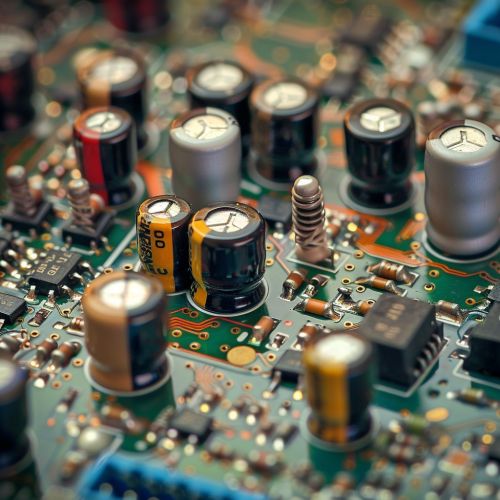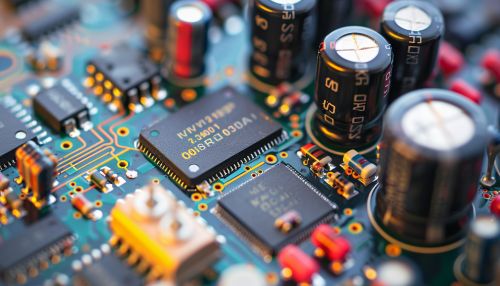Electronic Circuit
Introduction
An electronic circuit is a complex network of electrical components interconnected by conductive paths to perform a specific function. These components include resistors, capacitors, inductors, diodes, transistors, and integrated circuits. Electronic circuits are fundamental to modern technology, enabling the operation of a wide range of devices from simple household appliances to sophisticated computing systems.
Basic Components
Resistors
Resistors are passive components that oppose the flow of electric current, dissipating energy in the form of heat. They are characterized by their resistance value, measured in ohms (Ω), and their power rating, measured in watts (W). Resistors are used to control current, divide voltages, and in filtering applications.
Capacitors
Capacitors store electrical energy temporarily in an electric field. They are characterized by their capacitance value, measured in farads (F), and their voltage rating. Capacitors are used in timing circuits, filtering, and energy storage applications.
Inductors
Inductors store energy in a magnetic field when electrical current flows through them. They are characterized by their inductance value, measured in henrys (H). Inductors are used in filtering, energy storage, and transformer applications.
Diodes
Diodes are semiconductor devices that allow current to flow in one direction only. They are used for rectification, signal demodulation, and protection circuits. The most common type is the silicon diode, but there are also specialized types like Zener diodes and light-emitting diodes (LEDs).
Transistors
Transistors are semiconductor devices used to amplify or switch electronic signals. They are the building blocks of modern electronic devices. Transistors come in two main types: bipolar junction transistors (BJTs) and field-effect transistors (FETs).
Integrated Circuits
Integrated circuits (ICs) are complex assemblies of multiple electronic components fabricated onto a single piece of semiconductor material. ICs can perform a wide range of functions, from simple logic operations to complex signal processing.
Types of Electronic Circuits
Analog Circuits
Analog circuits process continuous signals. They are used in applications such as audio amplification, radio transmission, and sensor interfaces. Key components in analog circuits include operational amplifiers, analog filters, and oscillators.
Digital Circuits
Digital circuits process discrete signals, representing data in binary form (0s and 1s). They are used in computers, digital communication systems, and digital signal processing. Key components include logic gates, flip-flops, and microprocessors.
Mixed-Signal Circuits
Mixed-signal circuits combine both analog and digital components to process both types of signals. These circuits are used in applications like analog-to-digital converters (ADCs), digital-to-analog converters (DACs), and modems.
Circuit Design and Analysis
Schematic Diagrams
A schematic diagram is a graphical representation of an electronic circuit, showing the connections and components. It uses standardized symbols to represent different components, making it easier to understand and analyze the circuit.
Simulation
Circuit simulation involves using software tools to model the behavior of an electronic circuit before physically building it. Popular simulation tools include SPICE and Multisim. Simulation helps in identifying potential issues and optimizing the design.
Prototyping
Prototyping involves building a preliminary version of the circuit to test its functionality. This can be done using breadboards, stripboards, or printed circuit boards (PCBs). Prototyping is a crucial step in the design process to ensure the circuit works as intended.
Testing and Debugging
Testing and debugging involve verifying the circuit's performance and identifying any issues. Tools like oscilloscopes, multimeters, and logic analyzers are used to measure and analyze signals within the circuit.
Applications
Consumer Electronics
Electronic circuits are integral to consumer electronics such as smartphones, televisions, and home appliances. These devices rely on complex circuits to provide functionality and user interfaces.
Communication Systems
In communication systems, electronic circuits are used in transmitters, receivers, and signal processing units. They enable the transmission and reception of data over various media, including radio waves, optical fibers, and satellite links.
Industrial Automation
Industrial automation relies on electronic circuits for controlling machinery and processes. Programmable logic controllers (PLCs), sensors, and actuators are key components in automated systems.
Medical Devices
Electronic circuits are crucial in medical devices such as pacemakers, imaging systems, and diagnostic equipment. These circuits ensure precise control and monitoring of medical parameters.
Automotive Electronics
In automotive electronics, circuits are used in engine control units (ECUs), infotainment systems, and safety systems. They enhance vehicle performance, comfort, and safety.
Advanced Topics
Signal Integrity
Signal integrity refers to the quality of electrical signals as they travel through a circuit. Factors affecting signal integrity include impedance matching, crosstalk, and electromagnetic interference (EMI). Ensuring good signal integrity is crucial for high-speed and high-frequency circuits.
Power Management
Power management involves optimizing the distribution and consumption of electrical power within a circuit. Techniques include voltage regulation, power sequencing, and energy harvesting. Efficient power management extends battery life and reduces energy consumption.
Thermal Management
Thermal management is essential to prevent overheating and ensure reliable operation of electronic circuits. Methods include heat sinks, thermal pads, and active cooling systems. Proper thermal management enhances the longevity and performance of electronic devices.
Electromagnetic Compatibility
Electromagnetic compatibility (EMC) ensures that electronic circuits do not interfere with each other or with external devices. EMC considerations include shielding, filtering, and grounding techniques. Compliance with EMC standards is critical for regulatory approval.
Future Trends
Flexible Electronics
Flexible electronics involve circuits fabricated on flexible substrates, allowing for bendable and stretchable devices. Applications include wearable technology, flexible displays, and medical implants.
Quantum Computing
Quantum computing uses principles of quantum mechanics to perform computations. Quantum circuits use qubits instead of classical bits, enabling potentially exponential increases in processing power for certain tasks.
Internet of Things (IoT)
The Internet of Things (IoT) connects everyday objects to the internet, enabling data collection and control. IoT devices rely on advanced electronic circuits for sensing, communication, and data processing.


